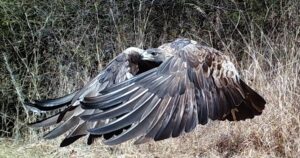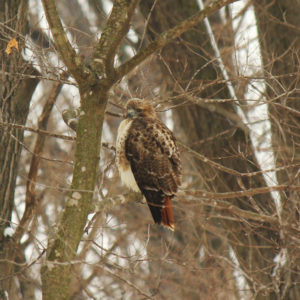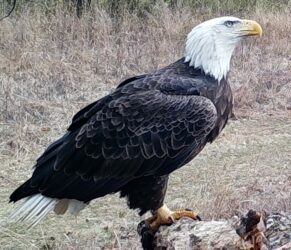By Evan Patrick
 The winter months provide some of the best chances to witness the wildlife that dwells within Bernheim Forest. The forestland, streams, prairies, glades, and wetlands that make up Bernheim’s 16,140 acres create a dynamic and resilient system of habitats that sustain thousands of species of plants and animals. One of the most charismatic groups of animals in the forest, the birds of prey, are active and highly visible this time of year.
The winter months provide some of the best chances to witness the wildlife that dwells within Bernheim Forest. The forestland, streams, prairies, glades, and wetlands that make up Bernheim’s 16,140 acres create a dynamic and resilient system of habitats that sustain thousands of species of plants and animals. One of the most charismatic groups of animals in the forest, the birds of prey, are active and highly visible this time of year.
The mid-winter, dormant landscape makes for ideal viewing opportunities. The trees have long since dropped their leaves, allowing a greater view into the forest. During clear, sunny days, these large birds can be seen riding high thermals (a thermal is a column of warm air caused by the warming of the surface by sunlight), surveying their habitat, and watching for prey. The shorter days of the winter mean fewer hours of daylight and reduced prey abundance, which reduces the amount of time that the birds are able to hunt. This increases their hunting activity during daylight hours, making viewing opportunities more abundant. We also have the greatest concentration of raptors during the winter as many migrate south to escape frozen landscapes up north.

Bernheim is home to several common birds of prey, readily identifiable by their red tails or shoulders- the red-tailed hawk, and the red-shouldered hawk. You can see these raptors perched upon a tall tree throughout the forest, perched atop a light pole near the Visitor Center, or soaring high above the Big Prairie searching for food. Another common, red-tinted bird of prey, the Cooper’s hawk, can be seen in forested areas, often feeding on birds captured in flight.
Sharp-shinned hawks, kestrels, and harriers are some of the less common birds of prey that call Bernheim home. Sharp-shinned hawks closely resemble Cooper’s Hawks but are less likely to be seen in suburban areas and are more likely to be found deep in the forest. Kestrels, the smallest falcon species in North America, can be found sitting high on a wire, or hovering low over a field, hunting for prey. Harriers are identifiable by a white patch at the base of their tales, and can be seen swooping low over open, wet areas.
 Some of the of the most enigmatic and revered birds of prey that dwell within Bernheim forest are bald and golden eagles. Both species are large and require intact, large, high quality habitat to thrive. The iconic bald eagle is more likely to be viewed in the Arboretum near Lake Nevin or seen perched atop a high branch overlooking a stream. Bald eagles often soar high on clear days in late winter over or near waterbodies, so watch the skies closely.
Some of the of the most enigmatic and revered birds of prey that dwell within Bernheim forest are bald and golden eagles. Both species are large and require intact, large, high quality habitat to thrive. The iconic bald eagle is more likely to be viewed in the Arboretum near Lake Nevin or seen perched atop a high branch overlooking a stream. Bald eagles often soar high on clear days in late winter over or near waterbodies, so watch the skies closely.
Golden eagles, like Athena and Harper, the breeding pair of eagles that utilize Bernheim as their winter habitat, are difficult to view. Understandably they are very wary of people and are keen to detect human presence by sight or sound. Golden eagles will soar high on clear days, catching thermals that push them upwards into the sky. They then descend by gliding and may travel great distances quickly. Sightings are often from very far away, and require patience, good binoculars, and dedication to keeping your eyes to the sky. Look high over forested knobs from the Bernheim Arboretum or Forest Hill Drive and be ready to distinguish golden eagles from vultures.
There is so much to see at Bernheim in the winter, and if the birds will not cooperate you can always enjoy a hike and appreciate winter botany. Best wishes on your bird outings and a tremendous thank you to all for supporting Birds of Bernheim.

